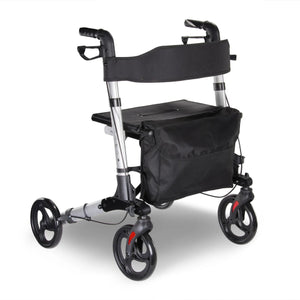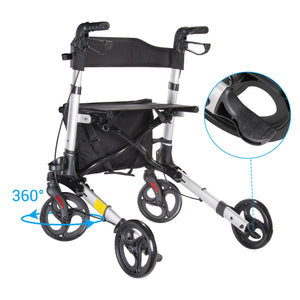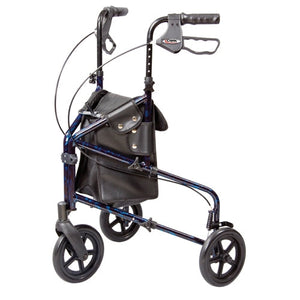This blog outlines 9 common types of mobility aids for seniors including rollators, standard walkers, folding walkers, and hybrid models. We discuss features, use-cases, and compare them side-by-side to help you decide the best type of walker for seniors with balance problems. For those unsure how to choose the right walker for elderly, our step-by-step guide covers everything from sizing to portability.
Introduction: Why Choosing the Right Walker Matters
With aging comes the need for support in daily movement. Walkers not only reduce the risk of falls but also improve independence. However, there’s no one-size-fits-all. You’ll need to consider height, usage environment, upper body strength, and whether the user has stability concerns.
Our comprehensive guide to the different types of walkers for elderly with features will help you choose a model that best suits the individual’s lifestyle, health status, and environment.
1. Standard Walker
This no-wheel model provides maximum stability and requires lifting with each step. Ideal for seniors with severe balance issues and upper body strength.
- Pros: Very stable, no movement without user input
- Cons: Slower pace, not ideal for long distances
2. Two-Wheeled Walker
This type adds front wheels to a standard walker, allowing smoother forward movement while maintaining rear-leg stability. It's great for indoor use and balance control.
3. Three-Wheeled Walker
Lightweight and maneuverable, these walkers have a tripod structure, perfect for indoor or tight spaces.
- Pros: Easy turning, compact
- Cons: Less stable than four-wheel models
4. Four-Wheeled Rollator
Popular for its seat, brakes, and ease of movement, this is the best walker with seat and wheels for seniors who need rest breaks or travel frequently.
5. Hybrid Walker-Rollator
Combines features of a rollator and transport chair, allowing caregivers to push the user when needed. Ideal for those who tire quickly but want to self-propel indoors.
6. Knee Walker
Used for ankle or foot injuries, this walker lets users kneel on a padded cushion and push with the healthy leg.
7. Folding Walker
Great for travel or storage, this style folds down flat. Compare options in our folding walkers vs wheeled walkers comparison section below.
8. Adjustable Walkers
Height-adjustable frames help customize for users of different statures. These adjustable walkers for elderly with height settings are critical for posture support and comfort.
9. Bariatric Walkers
Designed for heavier individuals, these walkers offer wider frames and reinforced support. Typically paired with dual-release folding and padded grips for stability.
How to Choose the Right Walker for Elderly
When choosing a walker, consider the following:
1. Mobility Level
For balance issues, choose a standard or two-wheeled walker. For more mobile users, rollators provide speed and convenience.
2. Environment
Indoor use requires compact, turning-friendly designs, while outdoor walkers should handle terrain and include brakes.
3. Storage & Portability
Frequent travelers should opt for folding walkers or lightweight three-wheeled options.
4. Strength & Weight Capacity
Bariatric models are essential for heavier users. All walkers list max weight support—check this before buying.
Folding Walkers vs Wheeled Walkers Comparison
|
Feature |
Folding Walkers |
Wheeled Walkers (Rollators) |
|
Stability |
High |
Moderate |
|
Ease of Movement |
Requires lifting |
Smooth glide with wheels |
|
Best For |
Home, small spaces |
Outdoor, active users |
|
Braking System |
None |
Yes |
|
Seat Available |
No |
Yes (in rollators) |
Frequently Asked Questions (FAQs)
What is the best type of walker for seniors with balance problems?
A standard or two-wheeled walker provides maximum balance support. Rollators offer less stability but more convenience. Always match the walker to the user’s physical condition.
How do I choose the right walker for an elderly parent?
Assess their mobility level, strength, and home layout. Choose a height-adjustable model and refer to our buying guide for walkers for elderly and disabled for personalized advice.
What is the difference between folding and wheeled walkers?
Folding walkers are compact and often used indoors, while wheeled walkers glide with ease, suitable for active seniors. See our folding walkers vs wheeled walkers comparison above.
Are rollators better for outdoor use?
Yes. In the rollator vs standard walker for indoor and outdoor use debate, rollators win for outdoor terrain and user convenience, especially if they include seats and brakes.
Do Moovkart walkers offer height adjustment?
Yes. All adjustable walkers for elderly with height settings at Moovkart include simple push-button customization to ensure proper posture and comfort.
Conclusion
Mobility aids can transform everyday life, and choosing from the different types of walkers for elderly with features ensures better comfort, safety, and independence. Whether it’s for indoor use, travel, or outdoor terrain, Moovkart has the perfect fit.
Use our buying guide for walkers for elderly and disabled to compare features, read user reviews, and evaluate price points. From compact folding frames to rollators with built-in seats, the right support is just a step away.
Need help selecting the best walker?
Visit Moovkart’s Walker Collection to explore walker types, user reviews, and exclusive pricing designed to support every senior’s journey to confident mobility.







